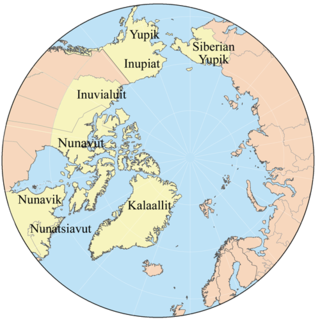
Eskimo is an exonym used to refer to two closely related Indigenous peoples: Inuit and the Yupik of eastern Siberia and Alaska. A related third group, the Aleut, which inhabit the Aleutian Islands, are generally excluded from the definition of Eskimo. The three groups share a relatively recent common ancestor, and speak related languages belonging to the Eskaleut language family.

The Inuit languages are a closely related group of indigenous American languages traditionally spoken across the North American Arctic and the adjacent subarctic regions as far south as Labrador. The Inuit languages are one of the two branches of the Eskimoan language family, the other being the Yupik languages, which are spoken in Alaska and the Russian Far East. Most Inuit people live in one of three countries: Greenland, a self-governing territory within the Kingdom of Denmark; Canada, specifically in Nunavut, the Inuvialuit Settlement Region of the Northwest Territories, the Nunavik region of Quebec, and the Nunatsiavut and NunatuKavut regions of Labrador; and the United States, specifically in northern and western Alaska.
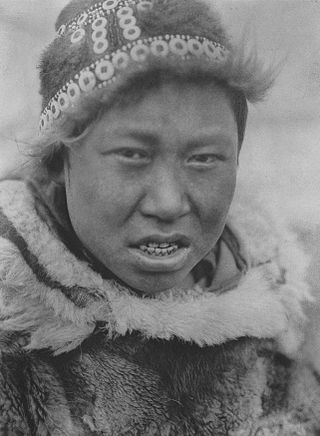
The Yupik are a group of Indigenous or Aboriginal peoples of western, southwestern, and southcentral Alaska and the Russian Far East. They are related to the Inuit and Iñupiat. Yupik peoples include the following:

The Iñupiat are a group of Indigenous Alaskans whose traditional territory roughly spans northeast from Norton Sound on the Bering Sea to the northernmost part of the Canada–United States border. Their current communities include 34 villages across Iñupiat Nunaat, including seven Alaskan villages in the North Slope Borough, affiliated with the Arctic Slope Regional Corporation; eleven villages in Northwest Arctic Borough; and sixteen villages affiliated with the Bering Straits Regional Corporation. They often claim to be the first people of the Kauwerak.

The Eskaleut, Eskimo–Aleut or Inuit–Yupik–Unangan languages are a language family native to the northern portions of the North American continent, and a small part of northeastern Asia. Languages in the family are indigenous to parts of what are now the United States (Alaska); Canada including Nunavut, Northwest Territories, northern Quebec (Nunavik), and northern Labrador (Nunatsiavut); Greenland; and the Russian Far East. The language family is also known as Eskaleutian, Eskaleutic or Inuit–Yupik–Unangan.
Traditional Inuit music, the music of the Inuit, Yupik, and Iñupiat, has been based on drums used in dance music as far back as can be known, and a vocal style called katajjaq has become of interest in Canada and abroad.

Bolas or bolases is a type of throwing weapon made of weights on the ends of interconnected cords, used to capture animals by entangling their legs. Bolas were most famously used by the gauchos, but have been found in excavations of Pre-Columbian settlements, especially in Patagonia, where indigenous peoples used them to catch 200-pound guanacos and rheas. The Mapuche and the Inca army used them in battle. Mapuche warriors used bolas in their confrontations with the Chilean Army during the Occupation of Araucanía (1861–1883).

The Inuit Circumpolar Council (ICC), formerly Inuit Circumpolar Conference, is a multinational non-governmental organization (NGO) and Indigenous Peoples' Organization (IPO) representing the 180,000 Inuit, Yupik, and Chukchi peoples people living in Alaska, Canada, Greenland, and Chukotka (Russia). ICC was ECOSOC-accredited and was granted special consultative status at the UN in 1983.

The Yupik languages are a family of languages spoken by the Yupik peoples of western and south-central Alaska and Chukotka. The Yupik languages differ enough from one another that they are not mutually intelligible, although speakers of one of the languages may understand the general idea of a conversation of speakers of another of the languages. One of them, Sirenik, has been extinct since 1997.

Iñupiaq or Inupiaq, also known as Iñupiat, Inupiat, Iñupiatun or Alaskan Inuit, is an Inuit language, or perhaps group of languages, spoken by the Iñupiat people in northern and northwestern Alaska, as well as a small adjacent part of the Northwest Territories of Canada. The Iñupiat language is a member of the Inuit-Yupik-Unangan language family, and is closely related and, to varying degrees, mutually intelligible with other Inuit languages of Canada and Greenland. There are roughly 2,000 speakers. Iñupiaq is considered to be a threatened language, with most speakers at or above the age of 40. Iñupiaq is an official language of the State of Alaska, along with several other indigenous languages.
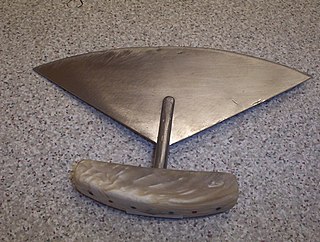
An ulu is an all-purpose knife traditionally used by Inuit, Iñupiat, Yupik, and Aleut women. It is used in applications as diverse as skinning and cleaning animals, cutting a child's hair, cutting food, and sometimes even trimming blocks of snow and ice used to build an igloo.

The umiak, umialak, umiaq, umiac, oomiac, oomiak, ongiuk, or anyak is a type of open skin boat, used by both Yupik and Inuit, and was originally found in all coastal areas from Siberia to Greenland. First used in Thule times, it has traditionally been used in summer, for moving people and possessions to seasonal hunting grounds, and for hunting whales and walrus. Although the umiak was usually propelled by oars (women) or paddles (men), sails—sometimes made from seal intestines—were also used, and, in the 20th century, outboard motors. Because the umiak has no keel, the sails cannot be used for tacking.

Masks among Eskimo peoples served a variety of functions. Masks were made out of driftwood, animal skins, bones and feathers. They were often painted using bright colors. There are archeological miniature maskettes made of walrus ivory, dating from early Paleo-Eskimo and from early Dorset culture period.

Traditional Alaskan Native religion involves mediation between people and spirits, souls, and other immortal beings. Such beliefs and practices were once widespread among Inuit, Yupik, Aleut, and Northwest Coastal Indian cultures, but today are less common. They were already in decline among many groups when the first major ethnological research was done. For example, at the end of the 19th century, Sagdloq, the last medicine man among what were then called in English, "Polar Eskimos", died; he was believed to be able to travel to the sky and under the sea, and was also known for using ventriloquism and sleight-of-hand.

The Yup'ik or Yupiaq and Yupiit or Yupiat (pl), also Central Alaskan Yup'ik, Central Yup'ik, Alaskan Yup'ik, are an Indigenous people of western and southwestern Alaska ranging from southern Norton Sound southwards along the coast of the Bering Sea on the Yukon-Kuskokwim Delta and along the northern coast of Bristol Bay as far east as Nushagak Bay and the northern Alaska Peninsula at Naknek River and Egegik Bay. They are also known as Cup'ik by the Chevak Cup'ik dialect-speaking people of Chevak and Cup'ig for the Nunivak Cup'ig dialect-speaking people of Nunivak Island.
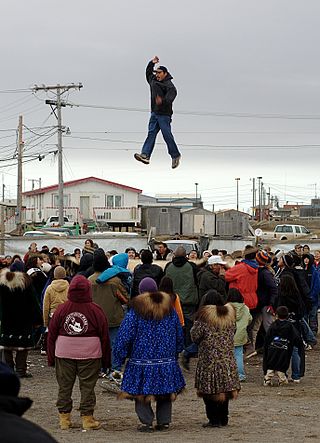
Nalukataq is the spring whaling festival of the Iñupiat of Northern Alaska, especially the North Slope Borough. It is characterized by its namesake, the dramatic Eskimo blanket toss. "Marking the end of the spring whaling season," Nalukataq creates "a sense of being for the entire community and for all who want a little muktuk or to take part in the blanket toss....At no time, however, does Nalukataq relinquish its original purpose, which is to recognize the annual success and prowess of each umialik, or whaling crew captain....Nalukataq [traditions] have always reflected the process of survival inherent in sharing...crucial to...the Arctic."
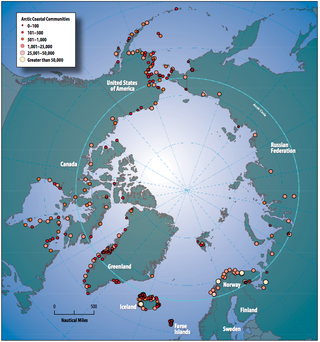
Approximately four million people hold residence in the Arctic Region, among which 10% are indigenous peoples belonging to a vast number of distinct communities. Circumpolar peoples and Arctic peoples are umbrella terms for the various indigenous peoples of the Arctic Region. They represent a minority with the exception of Greenland which 90% of its population is composed of Inuits. It is difficult to find an exact number of the indigenous peoples in the Arctic as states have a tendency to downplay the numbers. Moreover, each state has its own different methods to count its indigenous population. For instance, the Russian Federation excludes from the official status of "small peoples of the North" every community that exceeds 50 000 people. They are therefore excluding from the definition certain numerically large indigenous communities like the Komi, Karelian or Sakha people.

Inuit are a group of culturally and historically similar Indigenous peoples traditionally inhabiting the Arctic and subarctic regions of North America, including Greenland, Labrador, Quebec, Nunavut, the Northwest Territories, Yukon (traditionally), Alaska, and Chukotsky District of Chukotka Autonomous Okrug, Russia. Inuit languages are part of the Eskimo–Aleut languages, also known as Inuit-Yupik-Unangan, and also as Eskaleut. Inuit Sign Language is a critically endangered language isolate used in Nunavut.

The Paul H. Jensen Arctic Museum was a museum focused on the culture and environment of the Arctic in Monmouth in the U.S. state of Oregon. Located on the campus of Western Oregon University (WOU), the museum opened in 1985 with 3,000 artifacts collected by its late founder and namesake. The museum housed 5,000 artifacts and had exhibits on the wildlife of the Arctic along with displays that demonstrate the culture of the Inuit and Eskimo peoples of Alaska. The museum was one of only two museums focused on life in the Arctic located in the lower 48 states, and the only one on the West Coast. In 2013, WOU announced that the Jensen Museum would close its doors and the collections would move to the University of Oregon Museum of Natural and Cultural History (MNCH) at the University of Oregon in Eugene, which also has substantial Arctic collections.

Qargi, Qasgi or Qasgiq, Qaygiq, Kashim, Kariyit, a traditional large semi-subterranean men's community house' of the Yup'ik and Inuit, also Deg Hit'an Athabaskans, was used for public and ceremonial occasions and as a men's residence. The Qargi was the place where men built their boats, repaired their equipment, took sweat baths, educated young boys, and hosted community dances. Here people learned their oral history, songs and chants. Young boys and men learned to make tools and weapons while they listened to the traditions of their forefathers.



















